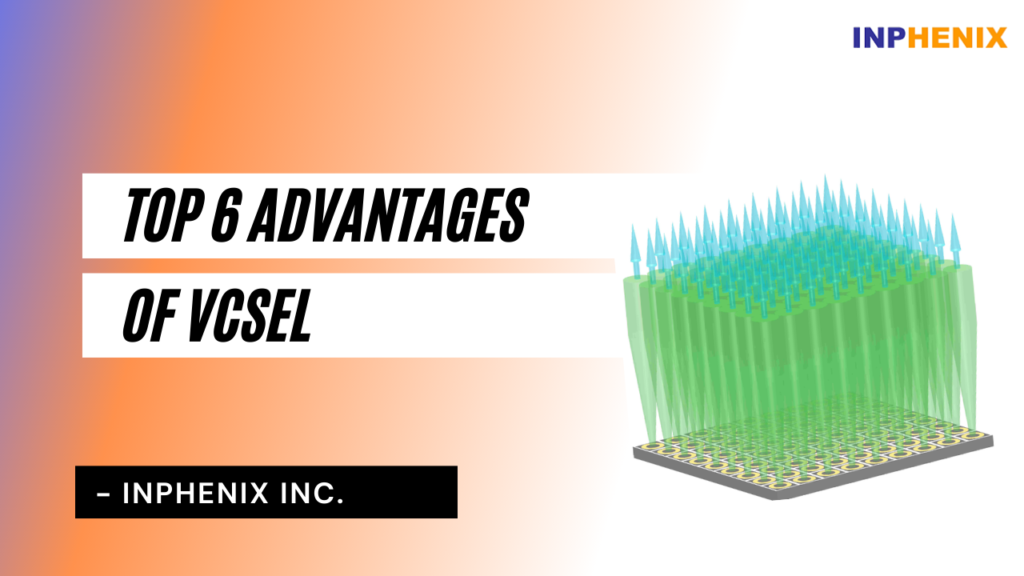
VCSELs (Vertical-Cavity Surface-Emitting Lasers) were invented in the mid-1980s. However, in a relatively short period of time, VCSEL established a reputation as a superior technology for short-distance applications such as fiber channel, Ethernet, and intra-systems communications.
Over the next few years, VCSELs displaced edge-emitter lasers as the technology of choice for short-range datacom and local area networks. VESSEL’s success can be primarily due to its lower manufacturing costs and improved dependability compared to edge emitters.

In this blog, we will look at the benefits of VCSELs in order to understand why they are regarded as one of the most effective lasers and why they are used in a variety of industries.
A vertical-cavity surface-emitting laser diode (VCSEL) is a semiconductor-based laser diode that produces light or an optical beam vertically from its top surface. This type has greater advantages than Edge Emitting Lasers (EEL), which emit light from the side, or Light Emitting Diodes (LED), which emit light from the sides and top.
Moreover, VCSELs are manufactured in multiple ways, the most common of which is to integrate them onto a wafer, where thousands of diodes can be integrated on the surface. Another option is to make them into arrays so that the output power can be increased.
When it comes to the VCSEL structure, is made up of layers of semiconductor material grown on top of one another on a substrate. This is commonly done in a molecular beam epitaxy (MBE) or metalorganic-chemical-vapor-deposition (MOCVD) growing reactor for VCSELs and edge emitters. For more information regarding VCSEL and its Characteristics visit here…
The formed wafer is further processed to create individual devices. Now, in the following section, we’ll look at the benefits of the VCSEL laser.
VCSELS, like many lasers, are used in optical communications. Vertical-Cavity Surface-Emitting Lasers are also more commonly used in long-wavelength communication technologies, such as those used in metro systems, storage networks, and fiber-to-home communications, than in other communication technologies.
The numerous benefits provided by VCSEL technology can be summarised as follows:
Growth technology has advanced to the point where VCSEL wafers are created with a cavity wavelength standard deviation of less than 2nm. This enables the manufacturing of VCSEL 2-D arrays with little wavelength variation between the array’s elements.
Since VCSEL devices can function at temperatures up to 80 degrees Celsius, the cooling system becomes very tiny, tough, and portable with this approach.
Since the lasing wavelength of a VCSEL is fixed by the short Fabry-Perot cavity, it is relatively stable. Unlike edge emitters, VCSELs can only function in one longitudinal mode.
The ability to manufacture VCSELs has been an important selling feature of this technology. Edge emitters have a low yield due to complex manufacturing processes and reliability difficulties associated with COD.
A fundamental advantage of VCSELs for high-power applications is that they can be easily processed into monolithic 2-D arrays, which edge emitters cannot. Furthermore, putting edge-emitter bars in stacks necessitates a sophisticated and thermally inefficient mounting strategy.
With the easy processing and heat-sinking technology, 2-D VCSEL arrays are much easier to package than an equivalent edge-emitter bar-stack. Heat removal for very high power arrays can be accomplished using existing silicon industry heat-sinking technologies. The cost of the high-power module will be greatly reduced as a result of this.
So that’s a fundamental understanding of VCSELs and their benefits. To see the applications VCSEL, check our blog: Applications of VCSEL In Various Industries.
Inphenix, based in the United States, is a prominent manufacturer of light sources and lasers. The company produces high-quality and reasonably priced light sources such as FP lasers, DFB lasers, swept-source lasers, gain chips, and many others. To learn more, contact us.
